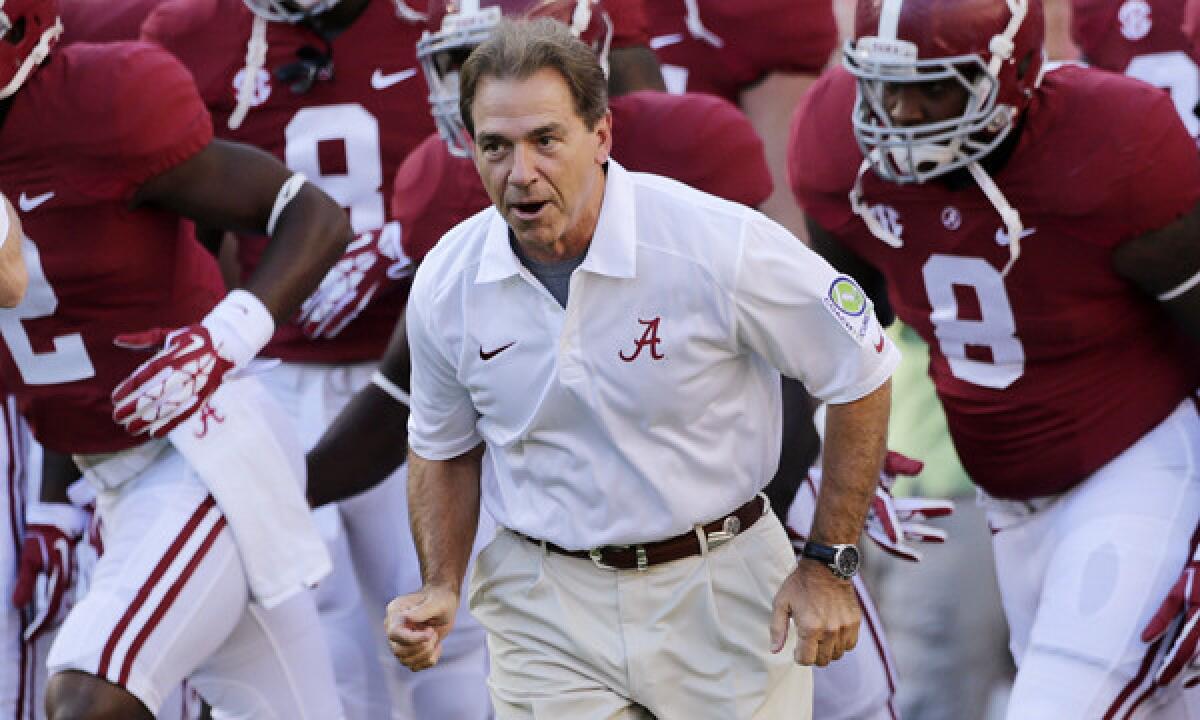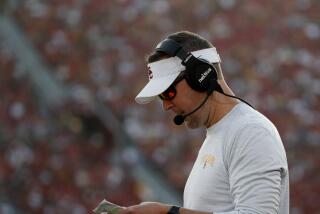College football calls off vote on controversial rule proposal

The most polarizing proposal in recent college football history was tabled Wednesday, as in shelved, one day before a NCAA rules committee was going to vote on the controversial pace-of-play issue.
The rule would have penalized a team for snapping the ball in the first 10 seconds of the 40 second clock.
The irony is the penalty would have been for delay of game.
There is nothing inherently wrong with studying whether or not up-tempo offenses pose a player safety concern. It makes some sense given hurry-up teams can run 20 to 25 additional plays per game.
That’s what Alabama Coach Nick Saban told ESPN on Wednesday only a few preemptive minutes before ESPN reported Thursday’s rules vote would not take place.
“I don’t care about getting blamed for this,” Saban said. “That’s part of it. But I do think that somebody needs to look at this very closely.”
What was wrong was trying to ramrod a ground-breaking rule through a committee before any definitive analysis could be established.
Let me get this straight: They were going to pass this rule and then study it?
Washington State Coach Mike Leach, a harsh critic of the proposed rule change, said he was happy the rules committee came to its senses.
“The whole proposal is ridiculous,” said Leach, who runs a fast-paced offense in Pullman, in a phone interview. “The whole thing is dysfunctional. Crazy. You can’t just make changes to the rule book, aimlessly, just because.”
Leach said he hoped this was the end of it.
“I don’t know,” he said. “It’s crazy. It should be over.”
What was also wrong was having Saban attached as the messenger for the cause, given he is a slow-pace advocate whose last three defeats have come against up-tempo opponents.
Saban claims he had no influence over the proposal other than to be, generally, in favor of it.
He also spoke to the rules committee about his player safety concerns.
Saban’s heart may be in the right place, but, in its present-day context, his coaching brethren simply weren’t buying it.
The proposal, as received by the public, smacked of duplicity and shamelessness.
Many coaches viewed “player safety” as a smokescreen for trying to implement a rule that would hurt schools trying to compete with Alabama, a run-first power program that has won three of the last five national titles.
“It was so transparent,” Leach said.
The proposal would have had more heft backed from a coach who ran a fast-paced offense, or one who at least did not appear to have ulterior motives.
An ESPN survey revealed only 25 out of 128 major college coaches were in favor of proposal.
A simple show of hands at the coaches’ convention could have killed this idea in January.
Coaches trying to compete against Saban had every right to be suspicious of his intentions. How could the proposal backlash have been a surprise?
“I think there was enough outcry and enough facts that they thought it wasn’t a good time to implement that rule,” said Arizona Coach Rich Rodriguez, considered “The Godfather” of the modern spread offense, after spring practice.
In the end, only hours before having to vote on the doomed rule, a face-saving idea was hatched: Give the idea more time.
And I’m fine with that.
But, while they’re studying whether up-tempo offenses are potentially dangerous, the experts need to also definitively examine whether run-oriented teams are more susceptible to concussions.
Is it more dangerous for power teams like Stanford and Alabama to initiate collisions with behemoth linemen?
They have weight caps in Pop Warner Football. Should we consider one at the school where Pop Warner once coached?
What about a study on that decisive play in the Rose Bowl in which a sea of humanity met at the 34 yard line?
Stanford deployed its special “elephant” package in which it put additional offensive linemen in the backfield to block.
Michigan State countered by stacking the defensive line with its own set of giant counterweights.
Needing a foot to extend the game, Stanford quarterback Kevin Hogan handed off to fullback Ryan Hewitt, who was met in midair by Spartans linebacker Kyler Elsworth.
The field looked like a crash on the 405 freeway.
What was the total weight on the field at the time? What was the risk to the player squished at the bottom of the pile?
Was he safer than a safety trying to cover a slot man in a spread offense?
While you’re studying the impact of the hurry-up offense, please also examine:
--Is it dangerous for Alabama to play outmanned 1-AA schools like Chattanooga and Western Carolina?
--One reason teams play up-tempo is they don’t have access to the kinds of players that Alabama can attract. Is it fair the Crimson Tide can recruit a disproportionate number of future NFL linemen weighing in excess of 350 pounds?
How about, in exchange for slowing pace of play, college football agrees to a draft of high school players? That would even the playing field and reduce the need for schools like Texas A&M to have to try and out-pace teams like Alabama.
Also, how about a safety look at Navy and Georgia Tech, schools that operate run-option offenses that require nimble linemen to chop block their opponents?
Should the rules committee consider making Georgia Tech run a different offense?
A lot of us will be happy to discuss the dangers of pace of play, just as soon as the results of these other studies come in.
More to Read
Go beyond the scoreboard
Get the latest on L.A.'s teams in the daily Sports Report newsletter.
You may occasionally receive promotional content from the Los Angeles Times.











